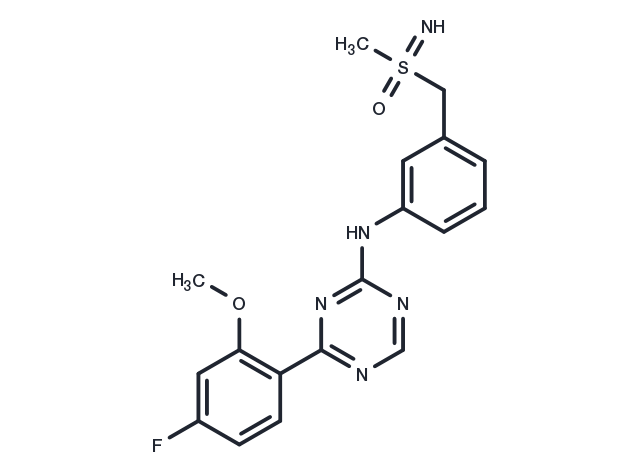Powder: -20°C for 3 years | In solvent: -80°C for 1 year


Atuveciclib Racemate (BAY-1143572 Racemate) is the racemate mixture of Atuveciclib, which is a potent and highly selective, oral P-TEFb/CDK9 inhibitor which supresses CDK9/CycT1 with an IC50 of 13 nM.

| Pack Size | Availability | Price/USD | Quantity |
|---|---|---|---|
| 1 mg | In stock | $ 112.00 | |
| 2 mg | In stock | $ 165.00 | |
| 5 mg | In stock | $ 289.00 | |
| 10 mg | In stock | $ 462.00 | |
| 25 mg | In stock | $ 867.00 | |
| 50 mg | In stock | $ 1,160.00 | |
| 100 mg | In stock | $ 1,570.00 | |
| 1 mL * 10 mM (in DMSO) | In stock | $ 318.00 |

| Description | Atuveciclib Racemate (BAY-1143572 Racemate) is the racemate mixture of Atuveciclib, which is a potent and highly selective, oral P-TEFb/CDK9 inhibitor which supresses CDK9/CycT1 with an IC50 of 13 nM. |
| Targets&IC50 | Apoptosis:385 nM(AML cell lines), P-TEFb/CDK9:13 nM, Antiproliferative:310 nM(MOLM-13 cells), Antiproliferative:920 nM(HeLa cells) |
| In vitro | Atuveciclib (BAY-1143572) exhibits a potent and highly selective inhibitory effect on PTEFb-kinase, specifically against PTEFb/CDK9, in the low nanomolar range, demonstrating at least 50-fold higher selectivity over other CDKs. The compound effectively inhibits the proliferation of seven AML cell lines, both with and without MLL rearrangements, evidenced by a median IC50 of 385 nM (ranging between 230-1100 nM), and it also triggers apoptosis[1]. Furthermore, Atuveciclib (BAY-1143572) differentiates itself by showing significant selectivity against a broad array of non-CDK kinases, coupled with wide-ranging antiproliferative effects across various tumor cell lines indicated by sub-micromolar IC50 values. Notably, it leads to the concentration-dependent inhibition of RNA polymerase II phosphorylation, subsequently diminishing MYC mRNA and protein levels[2]. |
| In vivo | Atuveciclib (BAY-1143572) significantly enhances its effectiveness when used with various chemotherapeutics across different solid tumor models. Additionally, it reduces MYC mRNA levels in the blood cells of treated rats, suggesting the potential of using MYC as a pharmacodynamic marker during clinical trials. When administered orally once daily, Atuveciclib demonstrates efficacy as a single agent, achieving partial or complete remission in most AML (acute myeloid leukemia) xenograft models in both mice and rats, proving its potency and tolerability at certain doses. |
| Synonyms | BAY-1143572 Racemate |
| Molecular Weight | 387.43 |
| Formula | C18H18FN5O2S |
| CAS No. | 1414943-88-6 |
Powder: -20°C for 3 years | In solvent: -80°C for 1 year
DMSO: 100 mg/mL (285.11 mM)
You can also refer to dose conversion for different animals. More
bottom
Please see Inhibitor Handling Instructions for more frequently ask questions. Topics include: how to prepare stock solutions, how to store products, and cautions on cell-based assays & animal experiments, etc.
Atuveciclib Racemate 1414943-88-6 Cell Cycle/Checkpoint CDK BAY-1143572 Racemate Atuveciclib BAY1143572 Cyclin dependent kinase inhibit Inhibitor BAY 1143572 BAY-1143572 inhibitor
